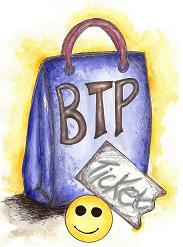We have already briefly discussed the endowment effect, but research has shed light on the nature of this economic bias, and so we thought it would be worth a deeper look.
At BtP, we are interested in how we make economic decisions and in the effects those decisions have on our lives. For instance, we have already discussed why I cling tenaciously to a 30-year old drumstick, despite never having played the drums. We have also considered why people are willing to spend $10.00 to replace a lost $10.00 movie ticket, even if they would never have paid $20.00 for the movie in the first place, and why being exposed to a random number can change the value we place on objects we are considering buying.
The endowment effect is a related quirk, and you’ll recognize this one, too. The endowment effect was nicely illustrated by a series of experiments in which people were shown to be unwilling to part with, for example, $0.10 in exchange for… $0.10. Once participants were given (endowed with) a coin, that coin suddenly acquired more value than the strict amount it was worth as currency. Now, in order to sell the dime, participants wanted more than $0.10. The same is found with nearly everything. Once it is ours, the value of it goes up. Give someone a coffee mug with a price tag of $5.00 on it and, unless they are desperate for the $5.00, they are not likely to part with it for a mere $5.00.
Try that one at home sometime: give your friends a quarter and see how much it costs you to buy them back!
The endowment effect is one of the most robust findings in behavioral economics, but many researchers believed that it was really just a special case of loss aversion. Recall that loss aversion is the quirk by which most of us wouldn’t cross the street to pick up a dollar — unless it had been ours in the first place, in which case we would dash madly through oncoming traffic. In general, we’ll take risks to prevent a loss, but not to realize a gain, and this quirk has real world consequences. When we consider healthcare options, financial options, you name it, whether the options are framed as losses or gains changes how we think about them and strongly influences our decision.
If you are thinking, Right… so, isn’t the endowment effect the same thing as loss aversion, you’d be in good company. However, a series of clever experiments demonstrated that there’s a difference. In the experiments, researchers set up a trading market in which participants took the roles of buyers and sellers of coffee mugs (in the real world, such markets exist among companies that manufacture coffee mugs and the stores that buy them and sell them to consumers). The trick of the experiment was that some buyers and some sellers received as a gift an example of they would later be trading. Now, they owned an example of the thing they were selling. Crucially, they weren’t selling the mug they owned, but mugs just like the ones they owned. Meanwhile, other buyers and sellers were not ‘endowed’ with a mug of their own.
As it turned out, people who owned a mug of they type they were trading demanded higher prices as sellers and were willing to pay more as buyers. Just owning a mug made the rest of the mugs they were trading more valuable, even though people were not trading their own mug. Because the participants were buying and selling mugs that weren’t their own, they weren’t losing anything in the trades, and so it couldn’t be loss aversion that was driving the price up. Instead, just the fact of owning an example of the mug drove the price up. Hence, the endowment effect is not the same as loss aversion.
So what? There are obvious lessons here for people who manage sales forces and for buyers of merchandise. There are also reasons for the rest of us to pay attention. Our natural inclination is to value what we already have more highly than others would. When considering whether it is worth hanging on to that stock, or whether you should accept an offer for your used car, try to step back and consider the thing more objectively. Ask yourself how you would establish the value of that item if you encountered it for the first time. You will make better decisions as a result.
At beyondthepurchase.com, we are interested in all of the influences on people’s spending habits, happiness, and values. To find out more about how your personality and values influence how you relate to money and spending, we encourage you to take our hidden buying motivations test, Consumer Susceptibility to Interpersonal Influence Scale, and the Materialistic Values Scale and Experiential Buying Tendencies Scales tests and find out about your own values — as well as those of your friends. We think you may learn a lot about how you and why you spend your money the way you do.
This blog post was written by Kerry Cunningham, a recent M.S. graduate from the Personality & Wellbeing Laboratory at San Francisco State UniversityFollow @kerryfc


